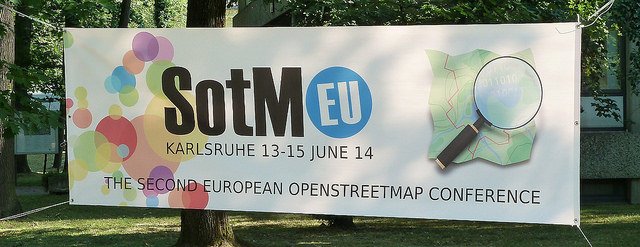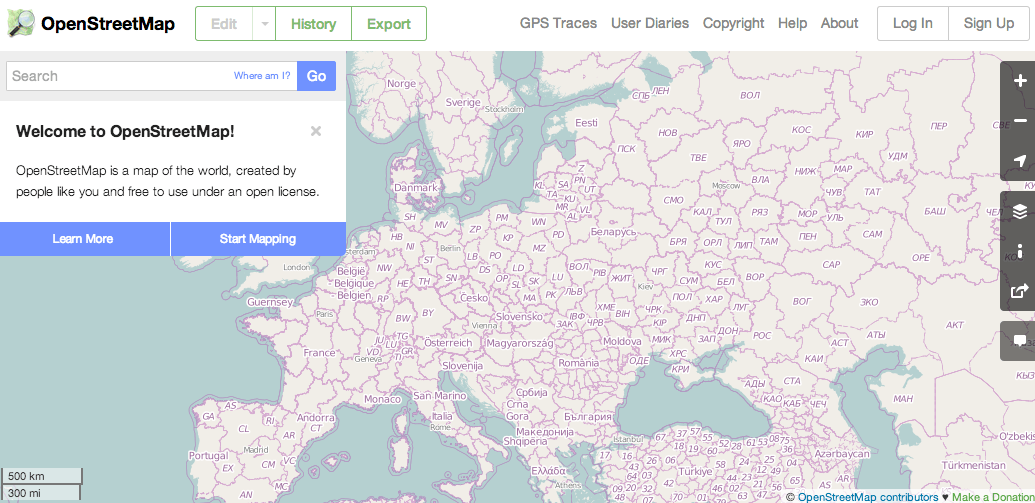Editor's note: This is a guest post from Ed Freyfogle, co-founder of Lokku (owners of OpenCage Data and investors in SplashMaps) and a member of the OpenStreetMap Foundation.
OpenStreetMap (OSM) has come a long way. After starting almost 10 years ago in London, OSM is now an entrenched part of the geo/location-based service toolchain and one of the leading examples of crowdsourcing at a massive scale.
Since 2004, over 1.5 million volunteers have signed up to contribute terabytes of geo-data to the project often referred to as the "Wikipedia of mapping". What began as one guy wandering around London with his GPS has now turned into a global movement and spawned countless spinoff projects (see: WheelMap, OpenCycleMap and OpenRailwayMap).
OpenStreetMap hitting critical mass
OSM seems to be increasingly becoming the datasource of choice, not just for hobbyists and cash starved startups, but also, slowly but surely, for enterprise and government users. As a result, the project is also putting more and more pressure on proprietary data suppliers (see the UK's Ordnance Survey's push to release "open" products over the last few years).
Recently, OSM founder Steve Coast declared the dataset to be "navigation ready". Beyond navigation other key areas for OSM include geo-coding (check out services like OpenCage, Pelias, Photon, and geo.io), gamification of data collection and validation (Kort and MapRoulette), 3D visualizations (Vizicities), vector-based maps, crowd-sourced streetview (Mapillary), disaster response (Humanitarian OpenStreetMap Team and SardSOS), and indeed even "offline" products like fabric maps (SplashMaps).
The State of the Map Europe – tackling questions around OSM as a datasource and community-driven project
With participants hailing across Europe and some from even farther afield, the OpenStreetMap community gathered for the State of the Map Europe conference which took place earlier this month in Karlsruhe, Germany.

Though the conference featured impressive geographic and cultural diversity, it unfortunately also suffered from an extreme lack of gender diversity. OSM is, at least as witnessed at this event, largely the realm of geeky men, a fact highlighted by the presence of only one female speaker out of 38. It's a stark contrast to the focused efforts of American OSMers hoping to broaden the community.
Indeed, some say the problem of inclusiveness goes much deeper. I have heard a few complaints that much of the infrastructure and defacto decision wielding power is held by the same group of volunteers as many years ago. One person even commented to me: "If you want to contribute as a sysadmin and get into the tech details you need to live in London and go to the pub with those guys."
Perhaps not the best recipe for a project with – literally – global ambitions.
Another point of concern is the seemingly endless debate surrounding the license under which OSM data and products are released. After spending an immense amount of time and energy a few years ago to move the project to the Open Database License (ODbL), some in the community are calling for another change.
The ODbL's viral nature and the ambiguity around it prevents well-intended integration with OSM from organizations legally required to put their data in the public domain (a famous example being New York City). Huge gray areas still exist – for example, does geo-coding using OSM fall into the category of a 'derived work'?), which unfortunately serves as a brake on widespread adoption of OSM.
For those interested in a real-world case study of this issue, David Blackman of Foursquare gave a good talk at the latest US State of the Map conference showcasing both the intriguing technical possibilities of OSM data, but also lamenting that issues around the license meant they feel unable to use OSM in production.
What's next?
Given the relative newness of digital crowd-sourcing and the speed of technical innovation in the space, it's probably not surprising that it takes time for legal interpretation and understanding to catch up. However, the lack of clarity around the license serves as a non-negligible barrier preventing many organizations from deeply embracing OpenStreetMap.
More worrying is the general case that in many ways the OpenStreetMap community has not yet decided how to interact with businesses. For instance, this year the OpenStreetMap Foundation (the non-profit that finance s– largely from donations – and runs the core infrastructure) announced corporate membership, but has so far failed to make it clear what the tangible benefits for a business might be. Understandably, uptake has been slow.
Similarly, there is not yet a clear consensus on how to handle the case of paid data contributors – should they somehow be treated differently than volunteers?
Finally, while OSM's comprehensiveness in most of the developed world is well beyond "good enough", there remain large tracts of the world without passionate local communities contributing and maintaining data.
A recent study found that just five countries make up 58% of OpenStreetMap's data coverage. It needs to be asked what dynamics are preventing local communities from forming around the world. Is OSM just a 'rich world' phenomenon? This is perhaps a fitting question for OpenStreetMap's next annual global meeting, which will be held for the first time ever in the southern hemisphere, in Buenos Aires, in November.
Despite all of these issues and ambiguities, OpenStreetMap has started to attract the attention of serious investors. In the last year, Berlin-based Skobbler was acquired for $24 million, and US-based Mapbox raised a $10 Million Series A round. However, the question is still open as to whether there are significant VC-style financial rewards to be around OpenStreetMap (as it is around open data in general).
SoTM image credit: Courtesy of Ed Freyfogle.


